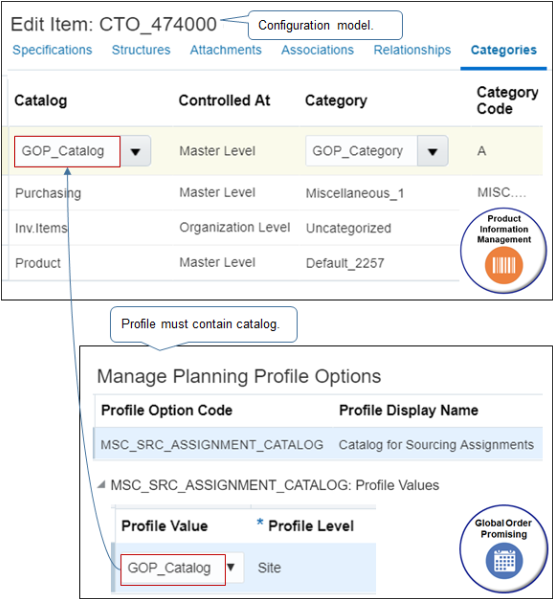Specify Catalog and Category for Your Configuration Model
A catalog is a collection of categories you use to classify your model and organize it in a hierarchy. Product Information Management associates each item it creates with the categories you set for the model.

Global Order Promising uses the category when it runs the available-to-promise rule for your model. The category helps Promising to recognize the configured item.
-
You must assign at least one catalog that the Catalog for Sourcing Assignments profile in Promising contains. Supply Chain Orchestration sends a request to Product Information Management to create the configured item, then copies the catalog to the item when Product Information Management creates the item.
-
In this example, Global Order Promising uses the predefined GOP_Category (Global Order Promising) to assign the configured item to the rule.
-
Make sure you assign each component in your model to an available-to-promise rule or associate it with a catalog that you assign to an available-to-promise rule.
-
If you don't set up the catalog and category correctly, the flow will usually create the configured item, but other downstream processing might fail, such as scheduling. For details, see Troubleshoot Problems with Configure-to-Order.
-
The Product Information Management work area might automatically add catalogs and categories to your model depending on how you set up the work area. It might still be necessary to add a catalog to support your configure-to-order flow.
For details, see Relationship Between Categories and Catalogs.
Try it.
-
Identify the category you must use.
-
Go to the Global Order Promising work area.
-
Click Tasks > Manage Planning Profile Options.
-
On the Manage Planning Profile Options page, search for the value.
Attribute
Value
Profile Option Code
MSC_SRC_ASSIGNMENT_CATALOG
-
In the search results, in the Profile Values area, note the value.
Attribute
Value
Profile Value
GOP_Catalog
This attribute identifies the catalog that Promising uses when assigning an assignment set. You specify this value in the Catalog attribute on your model in Product Information Management.
If you change the Profile Value, then you must specify your value on the model. For example, if you set Profile Value to my_value, then you must set the Catalog attribute on your model to my_value.
GOP_Catalog is an example. You can add a catalog in the Profile Values list and use it instead of GOP_Catalog.
-
-
Add the category to your item.
-
In the Product Information Management work area, click Tasks > Manage Items.
-
Search for, then open your model, such as CTO_474000 for editing.
-
On the Edit Item page, click Categories.
-
Click Actions > Add Row, set the values, then click Save.
Attribute
Value
Catalog
GOP_Catalog
Category
GOP_Category
-
-
Collect data and refresh the server. For details, see Collect Planning Data for Your Configuration Model.
Here are the catalogs that the flow copies to the configured item.
-
Inventory
-
Purchasing
-
Planning
-
Cost
-
Order Entry
-
Product Line Accounting
-
Asset Management
-
Distributed Order Orchestration
-
Order Capture
-
Pricing
-
Configurator
-
Supply Chain Financial Flow Orchestration
-